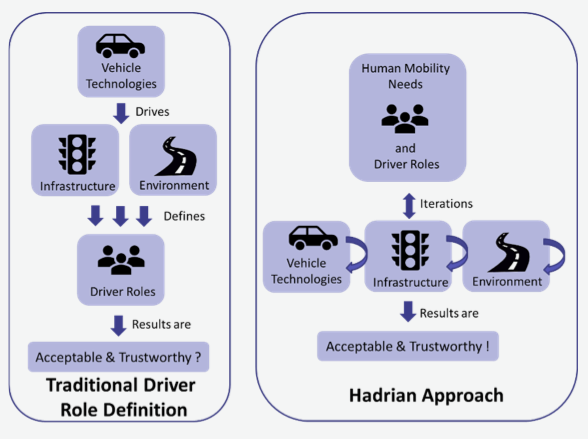Holistic Vision
HADRIAN differs from traditional approaches to develop driving automation systems (DAS) and therefore hopes to bypass some of the existing development hurdles. Whereas traditional approaches in the automotive domain focus on the vehicle itself to add automated driving as a new function that can be marketed and sold, HADRIAN focuses on developing mobility services that also include road infrastructure elements, and well, the human driver. Specifically, HADRIAN starts with concrete mobility needs of different driver mobility users in Europe for which concrete mobility service solutions can be designed, prototyped, and tested. For example, elderly people who become less adept in driving themselves need DAS solutions that help them stay mobile. Or professional truck drivers will need to be able to operate high-efficiency truck platooning operations that considerably change their role. Or busy office workers increasingly need to extend their work into the time spent for transportation that DAS vehicles will have to support. The idea is that is possible to shape DAS starting with the human mobility needs not with the driving function itself. This is the idea, in HADRIAN we will explore, validate, and show how this could be made a reality.

The HADRIAN f-HMI (fluid HMI)
The solution approach of HADRIAN is to define driver roles based on the fluid interface designs of f-HMI. The f-HMI is a multisensory, omnipresent, and omnidirectional system that constantly monitors the driver, his activities and attentional levels to update a driver “digital twin” model. In turn, the updates in the model are used to generate and select the proper sensory modality, timing and location to issue signals and communicate naturally with the driver. Like a fluid, it surrounds the driver and continuously adapts to his/her psychophysical “envelope”.
The underlying idea consists of enhancing the multisensory information available to the driver to
- increase situational awareness
- minimize obtrusiveness, and
- preserve the cognitive spare capacity for enabling prompt take-over-control of the vehicle, a smooth transition of control, and a comfortable and safe experience at all times.
The characteristics of a fluid interface enable the implementation of 3 AD functions:
- sustained monitoring of driver, passengers and environment, including V2V and V2X communication
- control management, including transitions of control (take over and hand back) across different levels of automation, and
- tutoring of native manual drivers towards increasing automation levels.

The HADRIAN f-HMI is the central development, in which all essential findings from the experimental studies flow together and which, conversely, is used in the planned field studies. This is accompanied by the development of the HADRIAN Fluid Tutoring System to prepare the driver optimally for the use of the AD system and to avoid over- or under-trust.
The HADRIAN f-HMI key elements
The HADRIAN f-HMI will combine multiple technological and HSI innovations.
The HADRIAN fluid tutoring system is context sensitive training method for driver to develop a more complete mental model of the automated system and increase its transparency and therefore acceptance and calibrated trust
The HADRIAN Fit2Drive system is intended to detect hazardous driver states such as distraction, fatigue, or inattention and to anticipate certain unsafe intentions before the vehicle could get into an inextricable situation that requires switching to a lower automation level or even force a sudden take-over by the human driver.
The HADRIAN haptic steering wheel feedback algorithm allows active and passive signaling to the driver during shared (human – automation) collaborative driving as well as to help transition back to manual driving.
The HADRIAN Head-Up Display will implement two different principles to facilitate fluid human-vehicle interactions. It will highlight critical information on a window-like display during transition situations or provide explanatory information for specific vehicle control interventions that are intended to increase the safety of certain driving situations.

